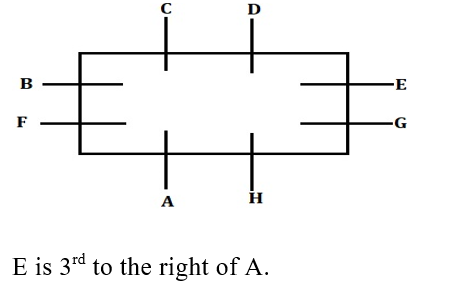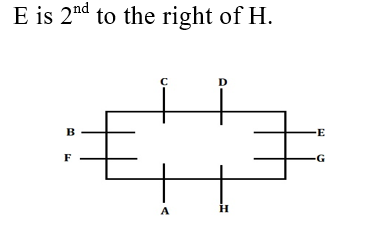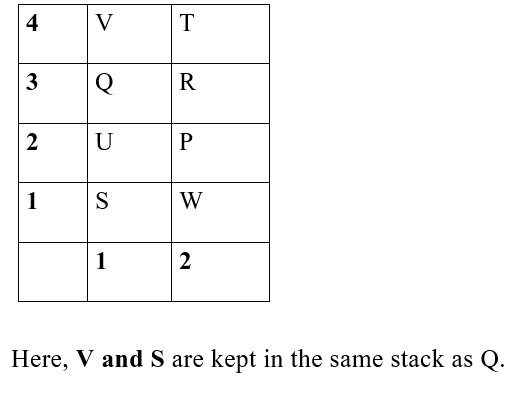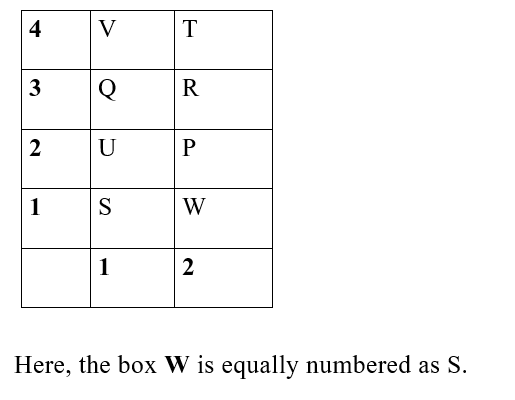Question 1:
Directions: Study the following information carefully and answer the questions given below:
निर्देश : नीचे दी गई सूचना को ध्यान से पढ़े तथा नीचे दिए गए प्रश्नों के उत्तर दें :
Eight persons A, B, C, D, E, F, G and H are sitting around a rectangular table in such a way that two persons are sitting on each side and all of them are facing the centre. A is facing C. B is 2nd to the left of A. D is 2nd to the left of B. One person sits between D and G. A and G are not on the same side. H is 2nd to the left of E. H is not facing G. F is not to the immediate left of B.
आठ व्यक्ति A, B, C, D, E, F, G तथा H एक आयताकार मेज के चारो ओर बैठे हैं| वे इस प्रकार बैठे हैं कि प्रत्येक सिरे पर दो व्यक्ति बैठे हैं और सभी केंद्र की ओर मुख किये बैठे हैं| A, C के सन्मुख है | B, A के बायीं ओर से दूसरे स्थान पर बैठा है| D, B के बायीं ओर से दूसरे स्थान पर बैठा है| एक व्यक्ति D तथा G के मध्य बैठा है| A तथा G समान सिरे पर नहीं है | H, E के बायीं ओर से दूसरे स्थान पर बैठा है| H, G के सन्मुख नहीं है | F, B के ठीक बायीं ओर नहीं है|
Who among the following sits 3rd to the right of A?
निम्न में से कौन A के दायीं ओर से तीसरे स्थान पर है?
Question 2:
Directions: Study the following information carefully and answer the questions given below:
निर्देश : नीचे दी गई सूचना को ध्यान से पढ़े तथा नीचे दिए गए प्रश्नों के उत्तर दें :
Eight persons A, B, C, D, E, F, G and H are sitting around a rectangular table in such a way that two persons are sitting on each side and all of them are facing the centre. A is facing C. B is 2nd to the left of A. D is 2nd to the left of B. One person sits between D and G. A and G are not on the same side. H is 2nd to the left of E. H is not facing G. F is not to the immediate left of B.
आठ व्यक्ति A, B, C, D, E, F, G तथा H एक आयताकार मेज के चारो ओर बैठे हैं| वे इस प्रकार बैठे हैं कि प्रत्येक सिरे पर दो व्यक्ति बैठे हैं और सभी केंद्र की ओर मुख किये बैठे हैं| A, C के सन्मुख है | B, A के बायीं ओर से दूसरे स्थान पर बैठा है| D, B के बायीं ओर से दूसरे स्थान पर बैठा है| एक व्यक्ति D तथा G के मध्य बैठा है| A तथा G समान सिरे पर नहीं है | H, E के बायीं ओर से दूसरे स्थान पर बैठा है| H, G के सन्मुख नहीं है | F, B के ठीक बायीं ओर नहीं है|
Which of the following pair does not belong to the group?
निम्न में से किस युग्म का समूह से संबंध नहीं है?
Question 3:
Directions: Study the following information carefully and answer the questions given below:
निर्देश : नीचे दी गई सूचना को ध्यान से पढ़े तथा नीचे दिए गए प्रश्नों के उत्तर दें :
Eight persons A, B, C, D, E, F, G and H are sitting around a rectangular table in such a way that two persons are sitting on each side and all of them are facing the centre. A is facing C. B is 2nd to the left of A. D is 2nd to the left of B. One person sits between D and G. A and G are not on the same side. H is 2nd to the left of E. H is not facing G. F is not to the immediate left of B.
आठ व्यक्ति A, B, C, D, E, F, G तथा H एक आयताकार मेज के चारो ओर बैठे हैं| वे इस प्रकार बैठे हैं कि प्रत्येक सिरे पर दो व्यक्ति बैठे हैं और सभी केंद्र की ओर मुख किये बैठे हैं| A, C के सन्मुख है | B, A के बायीं ओर से दूसरे स्थान पर बैठा है| D, B के बायीं ओर से दूसरे स्थान पर बैठा है| एक व्यक्ति D तथा G के मध्य बैठा है| A तथा G समान सिरे पर नहीं है | H, E के बायीं ओर से दूसरे स्थान पर बैठा है| H, G के सन्मुख नहीं है | F, B के ठीक बायीं ओर नहीं है|
Which of the following pair does not belong to the group?
निम्न में से किस युग्म का समूह से सम्बन्ध नहीं है?
Question 4:
Directions: Study the following information carefully and answer the questions given below:
निर्देश : नीचे दी गई सूचना को ध्यान से पढ़े तथा नीचे दिए गए प्रश्नों के उत्तर दें :
Eight persons A, B, C, D, E, F, G and H are sitting around a rectangular table in such a way that two persons are sitting on each side and all of them are facing the centre. A is facing C. B is 2nd to the left of A. D is 2nd to the left of B. One person sits between D and G. A and G are not on the same side. H is 2nd to the left of E. H is not facing G. F is not to the immediate left of B.
आठ व्यक्ति A, B, C, D, E, F, G तथा H एक आयताकार मेज के चारो ओर बैठे हैं| वे इस प्रकार बैठे हैं कि प्रत्येक सिरे पर दो व्यक्ति बैठे हैं और सभी केंद्र की ओर मुख किये बैठे हैं| A, C के सन्मुख है | B, A के बायीं ओर से दूसरे स्थान पर बैठा है| D, B के बायीं ओर से दूसरे स्थान पर बैठा है| एक व्यक्ति D तथा G के मध्य बैठा है| A तथा G समान सिरे पर नहीं है | H, E के बायीं ओर से दूसरे स्थान पर बैठा है| H, G के सन्मुख नहीं है | F, B के ठीक बायीं ओर नहीं है|
Who among the following is 2nd to the right of H?
निम्न में से कौन H के दायीं ओर से दूसरे स्थान पर है?
Question 5:
Directions: Study the following information carefully and answer the questions given below:
निर्देश : नीचे दी गई सूचना को ध्यान से पढ़े तथा नीचे दिए गए प्रश्नों के उत्तर दें :
Eight persons A, B, C, D, E, F, G and H are sitting around a rectangular table in such a way that two persons are sitting on each side and all of them are facing the centre. A is facing C. B is 2nd to the left of A. D is 2nd to the left of B. One person sits between D and G. A and G are not on the same side. H is 2nd to the left of E. H is not facing G. F is not to the immediate left of B.
आठ व्यक्ति A, B, C, D, E, F, G तथा H एक आयताकार मेज के चारो ओर बैठे हैं| वे इस प्रकार बैठे हैं कि प्रत्येक सिरे पर दो व्यक्ति बैठे हैं और सभी केंद्र की ओर मुख किये बैठे हैं| A, C के सन्मुख है | B, A के बायीं ओर से दूसरे स्थान पर बैठा है| D, B के बायीं ओर से दूसरे स्थान पर बैठा है| एक व्यक्ति D तथा G के मध्य बैठा है| A तथा G समान सिरे पर नहीं है | H, E के बायीं ओर से दूसरे स्थान पर बैठा है| H, G के सन्मुख नहीं है | F, B के ठीक बायीं ओर नहीं है|
How many persons are sitting between E and B, when counted from the left of E?
जब E के बायीं ओर से गणना की जाये, तो E और B के बीच में कितने लोग बैठे हैं?
Question 6:
Directions : Eight boxes, P, Q, R, S, T, U, V, and W, are kept in two stacks numbered 1 - 2 from west to east. There are four boxes in each stack and are numbered 1- 4 from bottom to top. Box V is kept immediately above the box Q, in the same stack. Box Q is kept in an odd-numbered stack and is odd-numbered. Box R is kept immediately below box T, in the same stack. Boxes V and T are equally numbered. Boxes P and W are kept in an even-numbered stack, and neither is kept at the top of the stack. Box U is even-numbered and is not equally numbered as the box W.
निर्देश : आठ बॉक्स, P, Q, R, S, T, U, V और W पश्चिम से पूर्व की ओर 1 - 2 तक संख्यांकित दो स्टैक में रखे गए हैं। प्रत्येक स्टैक में चार बॉक्स हैं और नीचे से ऊपर की ओर 1- 4 तक संख्यांकित हैं। बॉक्स V, बॉक्स Q के ठीक ऊपर समान स्टैक में रखा गया है। बॉक्स Q विषम संख्यांकित है और इसे एक विषम संख्यांकित स्टैक में रखा गया है। बॉक्स R, बॉक्स T के ठीक नीचे समान स्टैक में रखा गया है। बॉक्स V और T समान रूप से संख्यांकित हैं। बॉक्स P और W एक सम संख्यांकित स्टैक में रखे गए हैं और दोनों में से कोई भी बॉक्स स्टैक के शीर्ष पर नहीं रखा गया है। बॉक्स U सम संख्यांकित है और बॉक्स W के समान रूप से संख्यांकित नहीं है।
The box ___ is kept at the third position from the top of an even-numbered stack.
बॉक्स ___ को एक सम संख्यांकित स्टैक में शीर्ष से तीसरे स्थान पर रखा गया है।
Question 7:
Directions : Eight boxes, P, Q, R, S, T, U, V, and W, are kept in two stacks numbered 1 - 2 from west to east. There are four boxes in each stack and are numbered 1- 4 from bottom to top. Box V is kept immediately above the box Q, in the same stack. Box Q is kept in an odd-numbered stack and is odd-numbered. Box R is kept immediately below box T, in the same stack. Boxes V and T are equally numbered. Boxes P and W are kept in an even-numbered stack, and neither is kept at the top of the stack. Box U is even-numbered and is not equally numbered as the box W.
निर्देश : आठ बॉक्स, P, Q, R, S, T, U, V और W पश्चिम से पूर्व की ओर 1 - 2 तक संख्यांकित दो स्टैक में रखे गए हैं। प्रत्येक स्टैक में चार बॉक्स हैं और नीचे से ऊपर की ओर 1- 4 तक संख्यांकित हैं। बॉक्स V, बॉक्स Q के ठीक ऊपर समान स्टैक में रखा गया है। बॉक्स Q विषम संख्यांकित है और इसे एक विषम संख्यांकित स्टैक में रखा गया है। बॉक्स R, बॉक्स T के ठीक नीचे समान स्टैक में रखा गया है। बॉक्स V और T समान रूप से संख्यांकित हैं। बॉक्स P और W एक सम संख्यांकित स्टैक में रखे गए हैं और दोनों में से कोई भी बॉक्स स्टैक के शीर्ष पर नहीं रखा गया है। बॉक्स U सम संख्यांकित है और बॉक्स W के समान रूप से संख्यांकित नहीं है।
Box U is kept at the _____ position in the stack numbered ___.
बॉक्स U को _____ के रूप में संख्यांकित स्टैक में _____ स्थान पर रखा गया है।
Question 8:
Directions : Eight boxes, P, Q, R, S, T, U, V, and W, are kept in two stacks numbered 1 - 2 from west to east. There are four boxes in each stack and are numbered 1- 4 from bottom to top. Box V is kept immediately above the box Q, in the same stack. Box Q is kept in an odd-numbered stack and is odd-numbered. Box R is kept immediately below box T, in the same stack. Boxes V and T are equally numbered. Boxes P and W are kept in an even-numbered stack, and neither is kept at the top of the stack. Box U is even-numbered and is not equally numbered as the box W.
निर्देश : आठ बॉक्स, P, Q, R, S, T, U, V और W पश्चिम से पूर्व की ओर 1 - 2 तक संख्यांकित दो स्टैक में रखे गए हैं। प्रत्येक स्टैक में चार बॉक्स हैं और नीचे से ऊपर की ओर 1- 4 तक संख्यांकित हैं। बॉक्स V, बॉक्स Q के ठीक ऊपर समान स्टैक में रखा गया है। बॉक्स Q विषम संख्यांकित है और इसे एक विषम संख्यांकित स्टैक में रखा गया है। बॉक्स R, बॉक्स T के ठीक नीचे समान स्टैक में रखा गया है। बॉक्स V और T समान रूप से संख्यांकित हैं। बॉक्स P और W एक सम संख्यांकित स्टैक में रखे गए हैं और दोनों में से कोई भी बॉक्स स्टैक के शीर्ष पर नहीं रखा गया है। बॉक्स U सम संख्यांकित है और बॉक्स W के समान रूप से संख्यांकित नहीं है।
Which of the following boxes is kept in the same stack as Q?
निम्नलिखित में से कौन-सा बॉक्स, Q के समान स्टैक में रखा गया है?
Question 9:
Directions : Eight boxes, P, Q, R, S, T, U, V, and W, are kept in two stacks numbered 1 - 2 from west to east. There are four boxes in each stack and are numbered 1- 4 from bottom to top. Box V is kept immediately above the box Q, in the same stack. Box Q is kept in an odd-numbered stack and is odd-numbered. Box R is kept immediately below box T, in the same stack. Boxes V and T are equally numbered. Boxes P and W are kept in an even-numbered stack, and neither is kept at the top of the stack. Box U is even-numbered and is not equally numbered as the box W.
निर्देश : आठ बॉक्स, P, Q, R, S, T, U, V और W पश्चिम से पूर्व की ओर 1 - 2 तक संख्यांकित दो स्टैक में रखे गए हैं। प्रत्येक स्टैक में चार बॉक्स हैं और नीचे से ऊपर की ओर 1- 4 तक संख्यांकित हैं। बॉक्स V, बॉक्स Q के ठीक ऊपर समान स्टैक में रखा गया है। बॉक्स Q विषम संख्यांकित है और इसे एक विषम संख्यांकित स्टैक में रखा गया है। बॉक्स R, बॉक्स T के ठीक नीचे समान स्टैक में रखा गया है। बॉक्स V और T समान रूप से संख्यांकित हैं। बॉक्स P और W एक सम संख्यांकित स्टैक में रखे गए हैं और दोनों में से कोई भी बॉक्स स्टैक के शीर्ष पर नहीं रखा गया है। बॉक्स U सम संख्यांकित है और बॉक्स W के समान रूप से संख्यांकित नहीं है।
Which of the following boxes is equally numbered as box S?
निम्नलिखित में से कौन-सा बॉक्स, S के समान रूप से संख्यांकित है?
Question 10:
Directions : Eight boxes, P, Q, R, S, T, U, V, and W, are kept in two stacks numbered 1 - 2 from west to east. There are four boxes in each stack and are numbered 1- 4 from bottom to top. Box V is kept immediately above the box Q, in the same stack. Box Q is kept in an odd-numbered stack and is odd-numbered. Box R is kept immediately below box T, in the same stack. Boxes V and T are equally numbered. Boxes P and W are kept in an even-numbered stack, and neither is kept at the top of the stack. Box U is even-numbered and is not equally numbered as the box W.
निर्देश : आठ बॉक्स, P, Q, R, S, T, U, V और W पश्चिम से पूर्व की ओर 1 - 2 तक संख्यांकित दो स्टैक में रखे गए हैं। प्रत्येक स्टैक में चार बॉक्स हैं और नीचे से ऊपर की ओर 1- 4 तक संख्यांकित हैं। बॉक्स V, बॉक्स Q के ठीक ऊपर समान स्टैक में रखा गया है। बॉक्स Q विषम संख्यांकित है और इसे एक विषम संख्यांकित स्टैक में रखा गया है। बॉक्स R, बॉक्स T के ठीक नीचे समान स्टैक में रखा गया है। बॉक्स V और T समान रूप से संख्यांकित हैं। बॉक्स P और W एक सम संख्यांकित स्टैक में रखे गए हैं और दोनों में से कोई भी बॉक्स स्टैक के शीर्ष पर नहीं रखा गया है। बॉक्स U सम संख्यांकित है और बॉक्स W के समान रूप से संख्यांकित नहीं है।
Select the pair of boxes which are kept adjacent to each other in the same stack?
समान स्टैक में एक दूसरे के आसन्न रखे गए बॉक्स के युग्म का चयन कीजिए।










